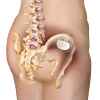About Sacral Neuromodulation
Sacral neuromodulation (SNM) is also called the bladder pacemaker. In Australia, it is indicated for patients with refractory overactive bladder or non-obstructive urinary retention. In all our patients, we perform a trial first before deciding if you are suitable to have the permanent battery implanted. It is considered a minimally invasive procedure as it is safe, does not cause permanent damage and the incisions are small and do not cause much post-op pain.
Pre-Operative Testing
There are two types of trial procedures (the staged trial or the peripheral nerve evaluation (PNE)) that help the doctor decide what to do next. Your doctor will decide which procedure is most appropriate for your condition.
Please note that A/Prof Gani only does the Staged Trial as it has been shown to have improved and more reliable results compared to a peripheral nerve evaluation.
Inform your doctor if you are taking any blood thinning or diabetic medications. Some of these must be stopped before the surgery. In general, you will need to fast for at least 6 hours before the surgery. Please speak to your doctor for more instructions. If you have a general anaesthetic or IV sedation, you are advised not to drive, smoke, drink alcoholic beverages or operate heavy machinery for 24 hours after the surgery. See preparing for surgery, for more information.
The Staged Trial
In an operating theatre and under general anaesthesia or IV sedation, the doctor will take a small lead/wire with four stimulation points and implant it under the skin in the sacrum (the bone just above your tailbone) near your sacral nerve. This is the ‘permanent’ lead/wire, which will be reused if you proceed to the Implant Phase. This is done with the help of X-rays to allow accurate placement of the lead / wire. Your reflexes are tested intra-operatively to see which location gives the best results. This procedure typically takes 60 – 90 minutes.
This is usually either a day procedure or patients may choose to stay overnight.
They will then connect this lead/wire to a second lead, which tunnels under the skin to the side of your buttocks where it will exit the skin. The second lead will then be connected to a small external temporary battery, which will supply electrical stimulation. This is attached to a belt that you wear for the 2-week trial.
At the end of the trial period, you will see your doctor again and you will discuss your experience.
- If you do not respond well to the SNM therapy, you will return to the operating theatre and your doctor will remove the wires and then decide what the next treatment option is.
- If you do respond well to SNM therapy, you will return to the operating theatre and the small wire in your sacrum will be connected to a small battery implanted under the skin (Pictured below).
You will be given a small controller (About the size of a mobile phone) which will allow you to communicate with the implanted battery to increase or decrease the stimulation, change the program, or turn it on and off.
The Peripheral Nerve Evaluation (PNE)
Under local anaesthetic, the doctor will take a small temporary lead/wire with a single stimulation point and implant it under the skin in the sacrum (the bone just above your tailbone) near your sacral nerve.
The lead/wire will be secured under some dressings and then connected to a small external battery, which will provide electrical stimulation.
You will wear this battery for 1-2 weeks to trial SNM therapy and determine what the next step in the therapy should be.
- At the end of the trial period, you will see your doctor again and they will remove the lead/wire and you will discuss your experience.
- If there is a good response, a permanent lead/wire and pulse generator / battery will be implanted in the operating theatre as a separate procedure.
Instructions during the Testing Phase
To minimise the lead from moving or being damaged, the activity instructions are:
- Take it easy. Keep your activity level low to moderate during the trial period.
- Avoid bending, stretching, and lifting heavy objects of more than 2kg (e.g., 2 litres of milk).
- Avoid pulling on the cables especially while getting in and out of bed, a chair, or car, etc.
- Use caution with normal activities such as getting dressed and putting on shoes.
- Keep bandages dry and intact. Do not try to remove bandages, as it may be difficult to reapply them yourself. If the dressing becomes soiled, wet or loose, reinforce new dressings over the top of the old dressings. You will be given extra dressings for this when you go home. A small amount of blood is normal.
- Do not get the device wet. Sponge bath only. Avoid baths, showers, and hot tubs. Do not submerge your body in water. You can wash your hair over the basin.
- Turn the test stimulator OFF while driving (it may remain on if you are a passenger).
- Take your oral antibiotics medications as prescribed. This helps to prevent infection.
Instructions for the test stimulator
- The test stimulator should always be connected to the cable that is connected to the implanted wire.
- You should feel gentle stimulation in the buttock / pelvic floor / genital area.
- Keep the stimulation turned on 24 hours per day, including when asleep or using the toilet.
- Check a few times each day to see if you can feel the stimulation. If you can’t feel it, turn it up slightly. Be careful of overstimulation as it can become uncomfortable.
- The amount of stimulation is under your control. Stimulation should never be uncomfortable. More stimulation does not make it more effective.
- If the stimulation has moved, is causing pain or discomfort, or causing your big toe to curl -reduce the level of stimulation till comfortable or turn it off and contact the device representative (contact details are given to you when you are discharged).
- The rep will be in touch with you during your trial period. Information is then passed on to your doctor, who will be aware of how you are doing during the whole trial period.
- During the trial period, sometimes you may be asked to change to a different program if you have not responded in the first week or so.
More hints and tips
- Body position may affect the intensity or location of the stimulation, which may cause you to have to adjust the stimulation.
- One way to avoid pulling on the wires is to keep the cable under your clothing. You may tape it on your body to reduce the extra slack.
- Complete the voiding diary as directed by your doctor.
- Do not drink more or less fluid than normal.
- Follow your doctor’s instructions regarding returning to work.
- A small amount of incision pain is normal.
- The chance of infection can occur any time the skin is opened. Follow doctor instructions regarding antibiotics. If you see signs of infection, contact your doctor’s office.
- If you see any other doctors during the trial, inform them you are trialling SNM Therapy.
- Return the test stimulator to your doctor’s office, hospital, or device representative on the day of your battery implant or lead/wire removal.
- Contact your doctor’s office if you have any questions or concerns.
Implantation
If you had good results during the Testing Phase, you may choose to proceed with the Implant Phase. This phase is typically done under IV sedation in the operating theatre. It takes about 30 minutes. It is usually a day procedure, or you may choose to stay overnight.
- If you had a temporary lead during your Testing Phase (PNE), this is replaced with a permanent lead.
- If you had a permanent lead during your Testing Phase (Staged trial), it will simply be reused.
The pulse generator / battery is implanted in the upper buttock area and connected to the permanent lead. This is then tested to make sure the stimulation is effective.
All the incisions will be closed with dissolvable sutures.
Post Operative
The device will be programmed and turned on before you leave the hospital, and you will be given instructions on how to use the programmer.
The sensation that you feel should be similar to what you felt during the Testing Phase. It should not be painful.
Most patients should be able to go home on the same day as your surgery.
Your incisions may feel sore, especially in the first 2 weeks.
You will be given painkillers and also antibiotics medications to take at home.
You can remove the dressings in 5 to 7 days’ time.
Avoid activities that may cause the implanted lead to move or that may damage the pulse generator (e.g., landing repeatedly on the buttock area).
Gradually increase your activity level as your incisions heal.
You should be able to shower and bathe as before and enjoy normal activities (such as travel, have sex, go to work, work in the garden etc.)
You may have to make some adjustments in your activities, such as turning the device OFF when you operate a vehicle, go through an airport security checkpoint, or being more aware of theft-prevention devices in stores.
There may be some interaction with other medical devices or procedures that you may have in the future – more written information will be given to you about this.
Occasionally, the pulse generator / battery may heal at an angled position and cause local discomfort when you lie on it, and it may need surgery be repositioned.
Since July 2021, an MRI compatible version has been available. There are rechargeable and non-rechargeable versions of the battery. The rechargeable one is smaller and needs about an hour of charging every 1 to 2 months. The non-rechargeable version has a battery life of 4 to 6 years on average. Longer battery life versions will be available in the near future.
You will be given a follow-up appointment to review your progress. Always bring your patient programmer with you to these appointments.


